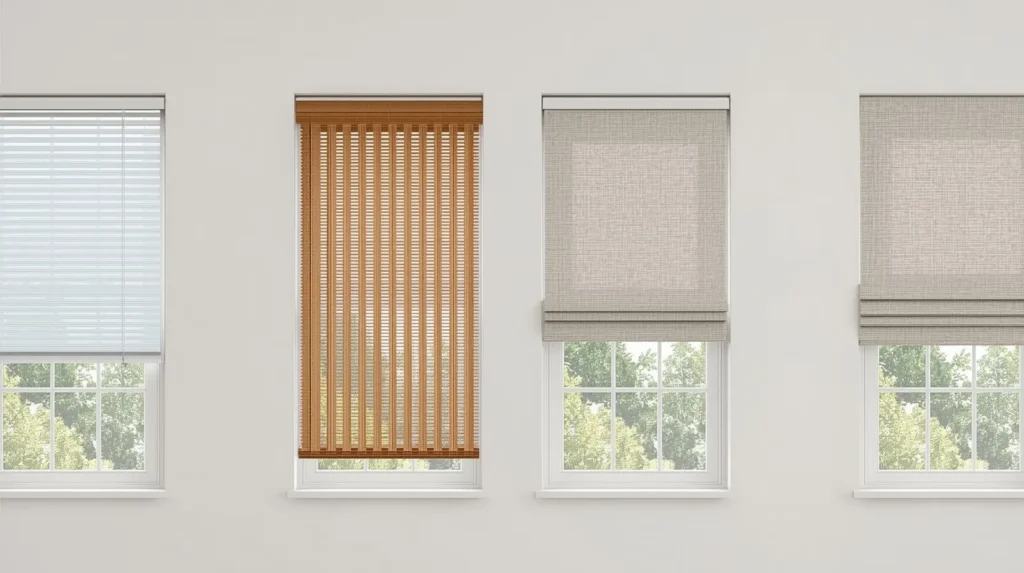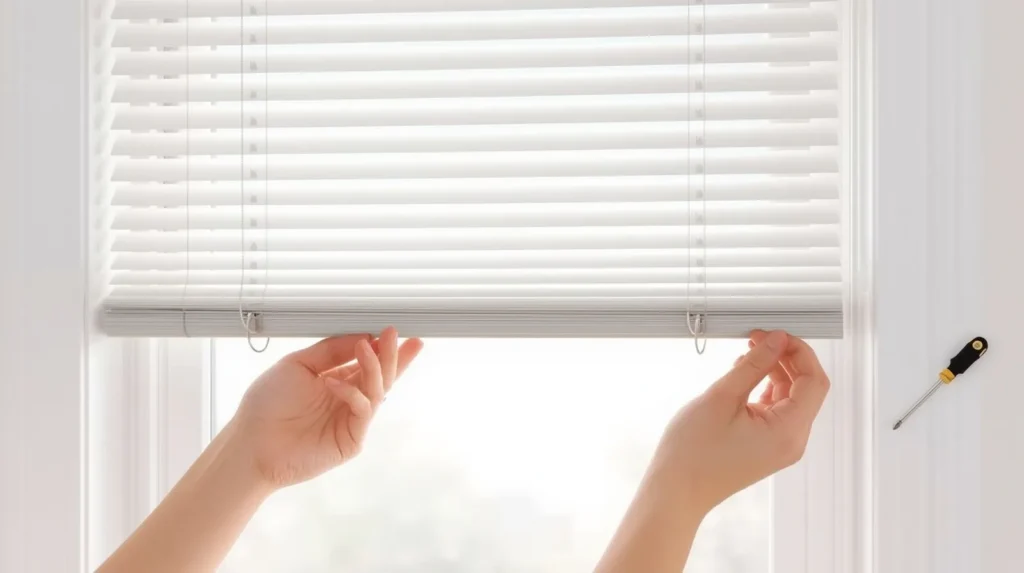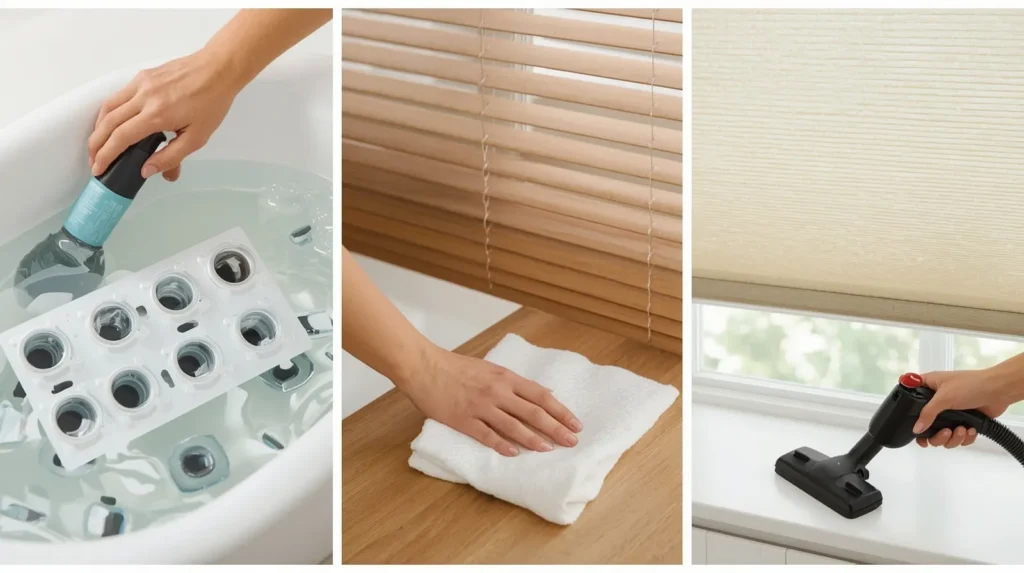Taking blinds down can feel intimidating if you’ve never done it before. But once you know where to look the clips, brackets, or latches it becomes simple. This guide explains how to take blinds down step by step, covering different types like roller shades, mini blinds, wooden blinds, and vertical blinds. You will also learn how to remove blinds safely for cleaning, painting, or replacing them with new window treatments. With the right tools, patience, and a little practice, anyone can do it without damage.
Why People Remove Blinds from Windows
Blinds are one of the hardest working parts of any home. They open and close every day, keeping out harsh sunlight, giving privacy, and adding a finished look to a room. Because of constant use, they naturally collect dust and may stop working as smoothly over time. For many homeowners, this is one of the main reasons to take blinds down. Cleaning is easier when the blinds are off the window, especially with horizontal blinds where dust builds up quickly.
Another common reason is home improvement. If you are repainting walls, repairing trim, or fixing a window frame, blinds can get in the way or end up with paint splatters. Taking them down before starting the project keeps them safe. Finally, many people remove blinds when they want to refresh their home’s style. Replacing older blinds with modern shades, shutters, or fabric treatments instantly changes the look of a room. Since blinds can usually be reinstalled, learning how to remove them properly is a helpful skill that saves time and avoids damage.
Understanding Different Types of Blinds and Shades

Before you start removing blinds, it is important to understand which kind you have, because each type is built with slightly different parts. Mini blinds are lightweight and made with thin vinyl or aluminum slats, which makes them simple to take down. Vertical blinds are designed with long panels that slide across a track, and these need a different removal process. Wooden blinds are heavier, whether they are real wood or faux wood, and it is usually safer to have two people handle them.
Some window coverings are made of fabric instead of slats. Roller blinds, for example, are just one piece of fabric wrapped around a tube, and they come off easily once unclipped. Venetian blinds are sturdier, with wider slats, but they work much like mini blinds. Cellular or pleated shades fold like an accordion or honeycomb and are held in place by snap-in brackets. Roman shades, on the other hand, fold neatly as they rise and are usually attached with headrails or clips. Knowing your blind type helps you figure out exactly where to press, lift, or unclip so the process goes smoothly.
Tools You May Need Before Removing Window Blinds
Blind removal does not require advanced equipment, but having the right tools prepared will make the process smoother and faster. A few simple items can prevent damage to your blinds, your window frame, and even your hands.
Recommended tools:
- Screwdriver – Most brackets use small screws that can be handled with either a flathead or Phillips screwdriver. It’s smart to keep both on hand, since you may not know which type you’ll need until you look closely at the bracket.
- Step stool or ladder – Many blinds are mounted high, especially on tall windows or sliding glass doors. A sturdy step stool or ladder ensures you can reach them safely without stretching or straining.
- Gloves – Dust and sharp metal edges are common around brackets. Wearing lightweight gloves helps protect your hands while also keeping your blinds cleaner during removal.
- Small container – When you remove brackets, screws, or clips, it’s easy for those tiny pieces to get lost. A small container, like a jar or plastic bag, keeps everything in one place so reinstallation later is simple.
- Flat tool – A butter knife, plastic card, or flathead screwdriver can be used to press hidden latches or slide behind a bracket cover. This is especially useful for blinds with hidden brackets.
- Dust mask – If your blinds haven’t been cleaned in a while, removing them will stir up dust. Wearing a simple mask can make the task more comfortable.
- Cleaning cloth – Having a microfiber cloth nearby lets you quickly wipe down the blinds as soon as they’re removed, saving time later.
- Helper (optional) – For heavier blinds such as wooden or extra-wide styles, a second person makes the job safer. One person can hold the blinds steady while the other unlocks the brackets.
Some blinds come with quick-release tabs that only need finger pressure, while others may hide small screws behind a decorative valance. Preparing these tools ahead of time ensures you can handle any type of blind without unnecessary delays.
How to Remove Blinds from Brackets Safely

Most blinds are secured with brackets, and once you understand how they work, removal becomes simple. The first step is to raise the blinds all the way to the top. This makes them shorter and easier to handle, reducing the risk of bending slats while you work. At each end of the headrail, you’ll find the brackets that hold the blind in place. Many of these brackets have a small cover or tab that needs to be opened before the blind can be released. You can usually do this with your fingers, but a small screwdriver makes it easier if the clip is tight.
Once the brackets are open, hold the headrail firmly with both hands and pull it forward in a steady motion. Some blinds also have an extra clip in the middle for added support, so check before applying too much pressure. After the headrail is free, set the blinds on a flat surface to prevent twisting or damage. This approach works for venetian blinds, horizontal blinds, and mini blinds, all of which rely on brackets for support.
Taking Down Blinds with Hidden or Metal Brackets
While standard brackets are straightforward, hidden brackets can be a little more challenging. These are designed to give windows a cleaner appearance, but the locking mechanism isn’t always obvious. To release them, look carefully under or behind the headrail until you find a small latch. Instead of pulling blindly, use a flat screwdriver to press the latch gently, which will unlock the headrail. At that point, you can pull the blind forward and away from the window frame.
Metal brackets work much the same way, but they tend to be firmer and may require slightly more pressure to release. The key is to apply steady force without bending the headrail, since it can warp if handled roughly. Once you’ve identified the release point, these brackets open without much effort. Though they may seem complicated at first glance, hidden and metal brackets are secure but simple once you understand their design.
Step-by-Step Guide: How to Take Blinds Down Without Damage
The process for removing most blinds follows the same pattern, and once you understand it, you can safely take down almost any type. Here’s a more detailed guide:
- Lift the blinds fully so the slats are stacked.
Always begin by pulling the cord or using the wand to raise the blinds as high as possible. This makes them compact, lighter, and much easier to handle. Working with blinds in their fully extended position adds unnecessary weight and increases the chance of bending or breaking the slats. - Support the blind with one hand.
Once the blinds are raised, place one hand under the headrail to keep it steady. Supporting the blind prevents it from falling suddenly once the bracket clips are released. If the blinds are heavy, such as wooden blinds, it may help to have a second person assist. - Release the bracket clips carefully.
Most brackets have small clips or covers that snap open. Gently press or lift these with your fingers or a flat screwdriver. Avoid forcing the clips, as too much pressure can break the plastic. Some blinds also hide extra screws behind a valance, so check before pulling. - Pull the headrail forward and out of the bracket.
With the clips released, use both hands to slide the headrail forward. Move slowly to avoid scraping the wall or damaging the window frame. If you feel resistance, stop and double-check for a hidden latch or screw still holding the blind in place. - Lay the blind flat to prevent bending or twisting.
Once the blind is free, place it gently on a clean, flat surface. This protects delicate slats from warping and makes it easier to clean, paint, or store the blind until you reinstall it.
The short answer to how to take blinds down is simple: release the bracket or clip, hold the blind steady, and slide it out slowly. Taking your time ensures you avoid scratches on the wall, damage to the headrail, or broken clips. With this careful approach, your blinds can be reinstalled later without any problems.
How to Take Down Shades and Roller Blinds
Shades and roller blinds are designed differently from standard horizontal blinds, so the removal process requires a slightly different approach. Roller blinds usually rest on a spring-loaded pin system. To remove them, press the pin at one end of the roller inward, which shortens the bar just enough to lift the opposite side out of its bracket. Cellular shades, often called honeycomb shades, are connected with snap-in mounting brackets.
To release them, press the small tab on the bracket and gently pull the headrail away from the window. Pleated shades work much like cellular shades, but they may include two release points instead of one, so both need to be pressed before the headrail can slide free. Roll-up blinds are even simpler, as they usually hang from hooks at the top. In most cases, you can just lift the roll upward and off the hooks. No matter which type you’re working with, always support the shade with your other hand while removing it. Fabric can crease or wrinkle if the shade falls suddenly, and proper handling ensures it stays in good condition for reinstallation.
Removing Specific Blind Styles: Mini, Vertical, and Wooden Blinds
Each type of blind has its own unique design, which means the removal process is not always the same. Mini blinds are among the simplest to take down because of their lightweight construction. They usually have small release tabs on the brackets, and sliding the headrail out requires very little force. Vertical blinds take a bit more effort. The individual slats must be unclipped from the track first, which makes the headrail lighter and easier to handle. Once the slats are removed, you can unfasten the track from its brackets.
Wooden blinds present a different challenge due to their weight. These blinds are heavier, so having two people is the safest approach one to hold the blind securely and the other to release the brackets. Venetian blinds, though similar to mini blinds, often include a decorative valance. Removing the valance first exposes the brackets, making it easier to release the headrail without damaging the trim. Knowing these differences helps you avoid forcing parts that aren’t designed to be pulled and protects the blinds from unnecessary damage.
Cleaning and Maintenance After You Take Blinds Off

Once blinds are removed, it’s the perfect opportunity to give them a thorough cleaning. Dust tends to settle on slats and fabric over time, and wiping them down while they are still mounted often leaves areas untouched. Taking the blinds off allows for deep cleaning and longer-lasting results. A microfiber cloth works well for a quick dusting, and a vacuum brush attachment can remove loose dirt from fabric shades. For mini blinds made of vinyl or aluminum, soaking them in a bathtub with mild soap and water is an easy way to restore their original shine.
Wooden blinds, however, should never be soaked in water. Instead, wipe them with a slightly damp cloth, followed by a dry cloth, and then polish them with a wood-safe cleaner to protect the finish. Fabric shades, such as cellular or pleated styles, should be cleaned gently with a vacuum brush or a handheld steamer. Regular maintenance not only improves appearance but also extends the life of the blinds, keeping them functional and attractive for years to come.
Common Problems and Quick Fixes When Removing Blinds
Even with careful preparation, blinds do not always come down without a challenge. Sometimes the brackets refuse to open, especially if they have been in place for many years. In this case, a flat screwdriver can provide the extra leverage needed to press the release tab more firmly. At other times, the headrail may feel stuck. This usually happens when a hidden screw or latch is holding it in place, often concealed behind a decorative valance.
Checking carefully before pulling prevents damage to both the blind and the wall. Clips can also break, particularly if they are made of plastic and have become brittle with age. Fortunately, replacements are widely available at hardware stores, making this a minor issue. Reinstallation can bring its own problems as well, with some blinds falling out of the bracket if they are not fully locked in. Ensuring that the headrail clicks securely into place prevents future accidents. Most of these problems are small and can be solved with patience and attention, allowing the removal process to go smoothly.
11. Professional Help for Window Blind Removal in Pasadena, CA
DIY blind removal is possible for most homeowners. But sometimes, professional help is the safer choice especially for oversized blinds, motorized blinds, or very heavy wooden blinds.
A trained installer will remove blinds quickly without damaging walls or windows. If you want peace of mind, hiring an expert is a smart move.
Keystone Group LLC has years of experience handling blinds, shades, and shutters. The team provides safe, careful removal and reinstallation. Many homeowners prefer this option to avoid accidents or costly mistakes.
Conclusion
Taking blinds down doesn’t have to be complicated. With the right tools, a little patience, and these step-by-step instructions, anyone can do it. Whether you’re cleaning, painting, or replacing your window coverings, you now know the safe way to remove blinds, shades, and curtains.
If you’d rather not handle it yourself, Keystone Group LLC is ready to help. The team ensures your blinds are removed quickly, safely, and with expert care.
Give your home a fresh start today by removing old blinds and making room for something new.
